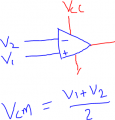Hello Guys,
I have some doubts on High Side current measurement. It would be a great help if some expert from this forum can help me to understand. My fundamental is really missing but trying to deep dive in it.
Q1. How the high-side current sensing can detect a load short to ground condition while not in low side measurement. This is not clear to me.

Q2. How common mode voltage of opamp impact the high side current measurement. As per my knowlege common mode voltage of opamp is Vcm = (V1+V2)/2 .

Q3. How the common mode voltage affect the output of below circuit ?
Q4. How to calculate the common mode voltage of this circuit ?
Q5. How to design below circuit ?
Q6. Is common mode voltage lies in +(non inverting ) of opamp ?


Q6. Vo = Ad*Vd+Acm*Vcm (opamp output)
In Above example how VCM value is going to affect the opamp output if we have higher CMRR ??
Thanks in Advance !
I have some doubts on High Side current measurement. It would be a great help if some expert from this forum can help me to understand. My fundamental is really missing but trying to deep dive in it.
Q1. How the high-side current sensing can detect a load short to ground condition while not in low side measurement. This is not clear to me.

Q2. How common mode voltage of opamp impact the high side current measurement. As per my knowlege common mode voltage of opamp is Vcm = (V1+V2)/2 .

Q3. How the common mode voltage affect the output of below circuit ?
Q4. How to calculate the common mode voltage of this circuit ?
Q5. How to design below circuit ?
Q6. Is common mode voltage lies in +(non inverting ) of opamp ?


Q6. Vo = Ad*Vd+Acm*Vcm (opamp output)
In Above example how VCM value is going to affect the opamp output if we have higher CMRR ??
Thanks in Advance !
Last edited:










